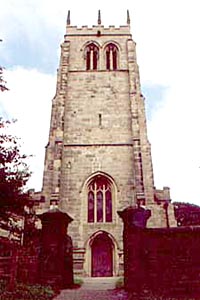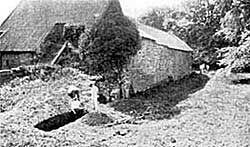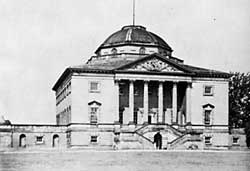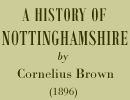< Previous | Contents | Next >
Greasley, Beauvale Priory and Nuttall

The 15th century tower of St Mary's church, Greasley (A. Nicholson, 2000).
Before inquiring what happened to the Carthusians at Beauvale, it will be well to see who it was that brought them hither, and what provision was made for them by the founder of the abbey. The gentleman who chose this retired spot for monastic purposes was one Nicholas de Cantilupe, lord of Ilkeston, and the owner of considerable property in Nottinghamshire and Derbyshire. The Manor of Greasley had come to the Cantilupe family by the marriage of Nicholas de Cantilupe with Eustachia, granddaughter and heiress of Hugh Fitz-Ralph, one of the great barons who, in the days of John, took up arms against the King. Of William de Cantilupe, their son, we have some glimpses in the ‘Parliamentary Writs,’ and it is evident that he was a powerful man in his day and generation. He is described as of Bedford and Nottingham, and having distinguished himself greatly in the French and Scottish wars of King Edward I., was summoned to Parliament as Baron Cantilupe from December 29, 1299, to August 5, 1308. He joined in a letter which was addressed to the Pope from Lincoln February 12, 1300, and is there styled ‘Dominus de Ravensthorpe.’ His grandfather had been steward to King John, and one of that monarch’s chief counsellors; while his uncle, Thomas de Cantilupe, became Lord Chancellor of England, being elected to that dignified office by the Barons in the 49th Henry III.

Excavating Greasley Castle in the 1930s.
Much might be written of the doings of distinguished members of the eminent and noble family of Cantilupe (so called from the original Champ de Loup or Campus Lupi), who came over with the Norman Conqueror, but we pass on to notice the stalwart warrior who founded Beauvale—Sir Nicholas de Cantilupe, third Baron, second son of William de Cantilupe, Lord of Eselburgh, in Bucks, Ilkeston, Greasley, and of several villages in the adjoining county of Lincoln. This nobleman served in the Flemish and Scottish wars of Edward III., and had summons to Parliament from 1337 to 1354. His principal residence appears to have been at Greasley, the mansion-house standing in a field near the church, where portions of it remain to this day. Having obtained the King’s permission to strengthen and fortify this abode, he converted it into a formidable fortress, and being embattled, it took the name of Greasley Castle, by which name it has been known ever since. The site is now occupied by a modern farmhouse, but incorporated with the out-buildings is one of the ancient walls, of great thickness and solidity. The trenches and works in the home field show that the castle was well protected, and that the fortifications around it were of an. extensive character. The fertile tract of country stretching from Greasley Church to the Erewash Valley was then a forest or park, and it was within this forest, in the Beauvale, that Nicholas the Warrior resolved to establish a religious house.
His lordship obtained the King’s license on September 2, 1343, to found a monastery ‘in his park of Greysley’ for a Prior and twelve monks of the Order of the Carthusians, and proceeded to endow it with £10 per annum rent, together with the park aforesaid and the advowsons of the churches of Greasley and Selstone. The foundation deed says that he did this and built the monastery ‘for those days; and their numbers had not become large, for it was the rule of the order that there should not be in a monastery more than twelve monks with their Prior, eighteen lay brethren, and a few paid servants.
But the ample revenues which had thus been provided were not suffered to remain untouched. Henry VIII. took the matter in hand in a way that is too well known to need description, and consternation reigned throughout the monastic orders. When his Majesty first indicated his intention to lay ruthless hands on the possessions of the monks, the leaders of the Carthusians prepared themselves for stubborn resistance. Prior Houghton, of the London Charterhouse, spoke out openly against the spoliation of Church lands by the King; and Prior Webster, of Beauvale, leaving the seclusion of his monastery, journeyed to London to make common cause with him against the royal edicts. But Henry would not brook opposition, and Prior Webster never saw his monks again.
The first blood shed on the scaffold, through Henry’s determination to forcefully thrust all obstacles out of the way, was that of Houghton, Webster, and three other Carthusians, who were hanged, drawn, and quartered at Tyburn, and their heads set on the City gates (May 5, 1535). Sir Thomas More saw them led to execution from his prison window, and said to his daughter (Mrs. Roper), who was with him, ‘Lo, dost thou not see, Megg, that these blessed fathers be now as cheerfully going to their deaths as bridegrooms to their marriage?’
Deprived of their Prior in this tragic manner, the monks of Beauvale were deeply agitated and grieved. Another Prior was appointed in the person of Robert Laurance, who was succeeded by Thomas Woodcock, and he and his brethren surrendered the monastery to the King on July 24, 1540.
Pensions were granted to Woodcock and to the following monks who were turned out: John Langforde, William Vell, Alexander Louthe, Edward Garnet, Robert Gowton, Nicholas Dookener, Thomas Lyghton, Thomas Wallshe, Richard Wakefield, and Richard Byrde.
The site of the priory and divers lands in the county belonging to it were granted to Sir William Hussey, and in the following reign to Richard Morison and Bridget, his wife.
 Nuttall Temple in the early 20th century.
The house was built in 1754-7 and partially demolished in 1929.
Nuttall Temple in the early 20th century.
The house was built in 1754-7 and partially demolished in 1929.As already mentioned, the spot where the abbey stood is now covered by a farmstead, known as the Abbey Farm, and incorporated in the outbuildings are considerable portions of the ancient monastery. The principal part of the ruins, which stand at the back of the house, form two sides of an open yard. An old building, which has had a modern roof put to it, consists of several apartments, the lower rooms being used as cowsheds, and an upper one as a fowl-house. This building is contiguous to massive ivy-covered walls, in which there have been some very fine windows. In the construction of the modern outbuildings a good deal of the old stone has been used, and in the wall of the house a piece of carved stonework is inserted. Judging by the formation of the ground, the abbey occupied a large space, and was protected by a deep moat, a part of which still remains. Thus travelling down the rich Erewash Valley, and lingering as we go over the historical associations which cluster around it, we come back to Nottingham, giving but a hasty glance at Nuttall with its stately temple, erected in imitation of the famous Villa Capra, near Vicenza; Watnall Chaworth and Cantelupe, at whose venerable Hall the Rollestons have resided since the days of ‘good Queen Bess’; Bramcote, with its picturesque scenery, its old manor-house, and its charming Hall, the residence of Mr. F. C. Smith; Chilwell, where another esteemed county family (the Charltons) have long resided in a mansion built on the site of a house that was once the property of Chief Justice Babington (temp. Henry VI.); and Beeston, for many years the residence of Mr. E. J. Lowe, J.P., F.R.S., the eminent astronomer, meteorologist, and author, and his lamented son, Captain A. E. Lawson Lowe, F.S.A., whose early death deprived the county of one of its ablest antiquaries and most diligent and accomplished literati.
Leaving Beeston, the villas of Nottingham Park and the gray walls of the castle are close upon us, and in a short time we are once more amid the whirl and bustle of a thriving and historic county town.
